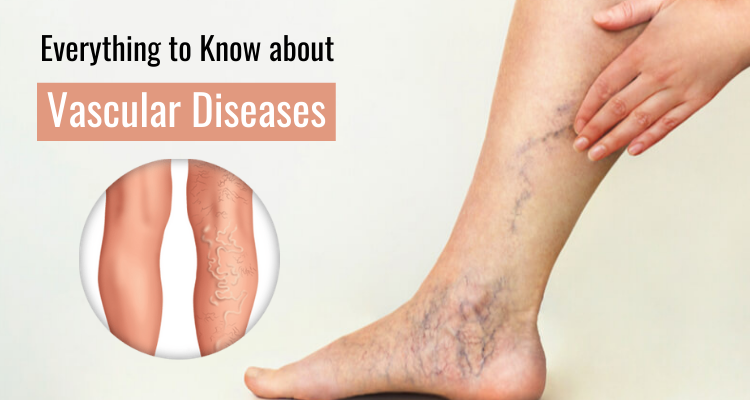Vascular disease is any condition that affects the blood vessels arteries and veins in human body, called the circulatory system. This can affect by blocking and weakening the blood vessels.
What is Vascular Disease? Types, Causes, and Preventions Explained
When the heart beats, it pump blood through blood vessels. These vessels are the tube that carry blood to every part of the body. Arteries take away blood from heart and veins bring back blood to the heart. This system is called circulatory system.
Vascular disease is the abnormal condition of the blood vessels. These vessels are used by the body to circulate blood through itself. Any problem with this vast network can cause severe disability and death.
Vascular disease such as peripheral artery disorder that affects the circulatory system. This ranges from problems to arteries, veins, and lymph to disorders that affects how the blood flows in your body. A disease can mean your vessels isn’t getting enough blood which can lead to some serious health problems, or even a life-threatening problems.
Here are a few conditions that fall under the vascular diseases: –
Arterial disease
Your peripheral artery may also develop atherosclerosis (fat build up and cholesterol deposits) just like the blood vessels. Over time, this will narrow the artery. Eventually the narrowed artery will cause less blood to flow in your body, and a condition called ischemia can occur. The common arterial disease include the following diseases: –
Peripheral artery disease
Feeling pain or cramps in legs (claudication) while doing an activity, walking, or running due to a blockage in the leg. Apart from this the common symptoms are changes in skin color, ulcers, sores, and feeling tired in the legs.
Intestinal ischemia disease
This condition occurs when the flood flow to the intestine decreases due to a blocked vessel, commonly an artery. This usually affects your small intestine or large intestine, or both.
Renal artery disease
A blockage in the renal artery can cause rental artery disease. The symptoms include abnormal kidney function,high blood pressure, and heart failure.
Popliteal entrapment syndrome
The enlarged calf muscle presses the artery behind the knee, popliteal artery. Which blocked the blood flow to the lower leg and foot.
Raynaud’s phenomenon
The condition when blood flow to your toes, fingers, ears and nose interrupted or blocked.
Buerger’s disease
This affects the blood vessels mainly in legs and arms. The blood vessels swell, which cause clot to form and this can lead to pain on legs and arms, tissue damages, and even gangrene.
Carotid Artery Disease
When the fatty deposits clog the blood vessels that supply blood to your brain and head. This can lead the risk of stroke, which occurs when the blood flow in brain decreases or interrupts.
Carotid artery dissection
Carotid artery is a set of two arteries at the sides of your neck which supplies blood to your brain. A tear in one of your carotid artery which lets the blood flow in between the layer of the wall and separate them.
Carotid body tumors
Carotid body tumors are the growth on the side of the neck on our body, where the carotid artery splits off smaller blood vessels that supply blood to the brain and head.
Carotid artery aneurysm
It is a bulge on one of your carotid artery in the side of your neck that supplies blood to the brain.
Venous disease
This disease occurs when the venous walls or valves are not working effectively, making it difficult for blood to flow back to the heart from the legs.
Blood clot
This forms inside a blood vessel, which can dislodge and travel through the blood stream. This can cause a deep vein thrombosis, heart attack or stroke.
Blood clots in the arteries may also cause severe leg pain, difficulty walking, or even the loss of a limb. And this usually caused by: –
- Hypercoagulable
- Axillo-subclavian vein thrombosis
- Pulmonary embolism
- Superficial thrombophlebitis
- Deep vein thrombosis (DVT)
Aortic Aneurysm
It is an abnormal bulge in the wall of a blood vessel. This commonly occurs in the aorta, which is the main blood vessel is leaving the heart.
Fibromuscular Dysplasia (FMD)
This is a rare medical condition. In this the patient has abnormal cellular growth in the walls of his medium and large arteries.Arteries may also become narrow in this condition.
Risk factors and causes of vascular diseases
Following are things caused by vascular diseases: –
- Buildup of plaque (fats and cholesterol deposits) in your arteries, called Atherosclerosis
- Blood vessels blocked by the mass of debris
- Trauma or injury
Some things can also increase the risk of getting vascular diseases that are as follows: –
- Stress
- High blood pressure
- Smoking
- Family history of vascular disease
- Lack of physical activity
- Cholesterol
- Obesity
- Diabetes
How to treat vascular diseases?
When the disease is severe then it requires to get treated by a vascular surgeon, but this can be controlled by doing the following: –
- Quit smoking and tobacco
- A healthy diet
- Exercise
- Stress management
If you aren’t diagnosed with vascular disease then these small changes can lead to a healthy lifestyle. Eat a healthy diet, quit smoke, and also do regular exercise.
But, if your case if serious then you have to seek medical treatment. Your primary doctor can refer you to the vascular surgeon in Delhi if needed.

